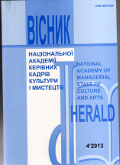Symphony works by А. Jacobchuk in a context of postmodernism of ukrainian music culture
DOI:
https://doi.org/10.32461/2226-3209.4.2013.138032Keywords:
Ukrainian music, Postmodernism, A. Jacobchuk, symphonyAbstract
The article deals with the symphonic works by contemporary Ukrainian composer Alexander Jacobchuk (born in 1952) in terms of its inclusion in the postmodern context Ukrainian musical culture. On the example of the Third and Fourth symphonies evolutionary processes in the genre, the role involved the poetry, especially author's style are investigated. The program and the vocal and choral elements introduction are specific features in the Third and Fourth symphonies. The Third one is dedicated to victory of Soviet people (and Ukrainian in its composition) during the World War II. Completed one year of the Second, Third symphony has some common features with the previous work of A. Jacobchuk's individual manner: increasing the role of codes that grows to scale expanded epilogue, picking the importance of philosophical synthesis, phase technique to achieve the highest climax, intonation roll between parts. Meanwhile, the artist applies new techniques of writing for yourself that will be characterized by further works. They are pastiche (in this case, the genre march – German and Soviet) and sonoristic texture with many layers caused by the simultaneous sounding of contrasting musical images. Program affects the cyclical features of the Third Symphony, where Part I represents the beginning of action, Part II – detached, due to childhood experiences, describes the basic feelings of the child, Part III – liquid phase – is a decisive turning point in development of events, and the final Part IV (festive march) conveys the joy of victory with the philosophical understanding of the code. The Fourth symphony elucidates starvation initiated by Stalin`s regime during 1932–33 in Ukraine. In this work A. Jakobchuk able to expand beyond his understanding symphonic genre, combining it with a requiem memorial service of God. Symphonic thinking visible in bright thematic connections between the parts as leitmotives (prayer, cluster moan, a theme of fate, the theme of protest) and dynamism of their development, application reception stylization, due to the need of the work program (in Parts III, V). Signs of requiem primarily are felt: in mourning nature of the work, the subject of poetry program with its idea of remembrance of the victims of hunger, and then to use postmodern musical text of the canonical Orthodox prayer ritual and spiritual purification achieved effect the audience. Based on a holistic analysis of the works conceptual expressiveness of their design and artistic identity of its implementation are shown. Third and Fourth Symphonies A. Jacobchuk demonstrate postmodern vision of the genre Symphony, which was shown to move away from a model of the genre, in bringing poetic words, availability of intertextuality. The above composition to some extent refute B. Syuta`s opinion that in the specified period of time "symphonic music samples are repeaters of the most well-established traditions and interdiscourses and certifying organization of artistic integrity based on conservative principles and proven scientific and artistic paradigms" [3, 219]. In further exploration we should trace the evolution of the entire symphonic creativity of A. Jacobchuk and its importance for Ukrainian symphonic music in general.Downloads
Published
Issue
Section
License
Authors who publish with this journal agree to the following terms:
1. Authors retain copyright and grant the journal right of first publication with the work simultaneously licensed under a Creative Commons Attribution License International CC-BY that allows others to share the work with an acknowledgement of the work's authorship and initial publication in this journal.
2. Authors are able to enter into separate, additional contractual arrangements for the non-exclusive distribution of the journal's published version of the work (e.g., post it to an institutional repository or publish it in a book), with an acknowledgement of its initial publication in this journal.
3. Authors are permitted and encouraged to post their work online (e.g., in institutional repositories or on their website) prior to and during the submission process, as it can lead to productive exchanges, as well as earlier and greater citation of published work (See The Effect of Open Access).


